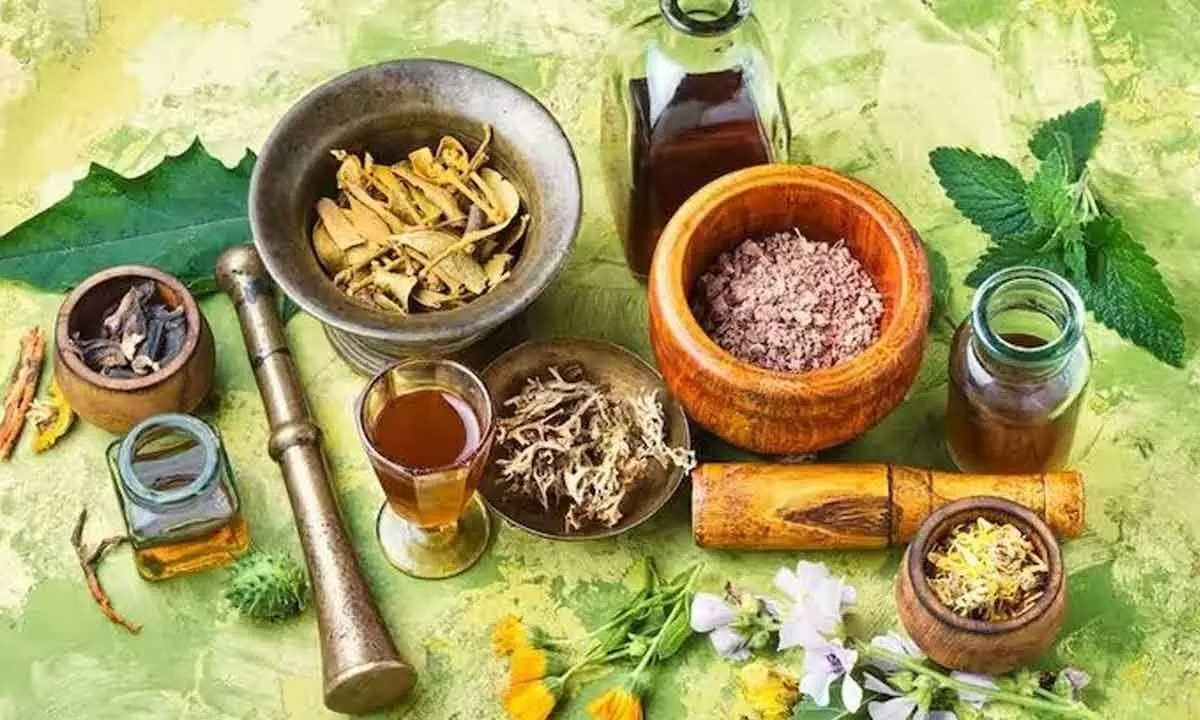Ayush ministry must safeguard Chandsi practitioners, revitalise ancient medical heritage
Medical certificates issued by practitioners of Ayurveda, Unani, Siddha and Sowa Rigpa are now officially approved
image for illustrative purpose

The term "Chandsi," derived from the Sanskrit word "Chikitsak," meaning practitioner, holds its roots in ancient medical traditions dating back to antiquity. The Chandsi method of treatment is believed to have originated from Hindu deities and goddesses
India is renowned for its diverse cultural rites, rich linguistic heritage and remarkable contributions to medicine. While Western medicine has undoubtedly transformed healthcare, India also boasts of an envious medical history. Ancient Indian healers, celebrated for their acute observational prowess, made pioneering discoveries that laid the groundwork for a robust medical tradition.
Dating back to the 3rd century BC, the pioneers of ancient medicine like Bogar, Tirumular, Sushruta, and Charaka emerged as towering figures in the annals of surgery and medical science. Their seminal contributions have profoundly influenced the trajectory of medicine, providing a solid foundation for future advancements.
Indian healthcare, steeped in ancient wisdom yet receptive to modern innovations, offers a distinctive perspective on healthcare delivery and medical practice globally. India has historically welcomed diverse influences, epitomizing the inclusive ethos articulated by Swami Vivekananda in his speech delivered on September 11, 1893.
This openness is evident in the assimilation of various medical traditions into India's healthcare landscape.
Sowa Rigpa, incorporating elements from Chinese and Greco-Arab medical systems, has evolved into a vital component of Tibetan Medicine, recognized by the Central Council of Indian Medicine since 2012.
Similarly, Unani or Yunani medicine (Al-Umoor al-tabiyah) medicine, rooted in the teachings of ancient Greek physicians and Galen, flourishes in South Asia under the stewardship of practitioners known as hakims. The Central Council of Indian Medicine acknowledges Unani medicine as per the IMCC Act of 1970.
The Indian government officially embraced homeopathy, originating from Germany, as a national system of medicine in 1973. The establishment of the Central Council of Homeopathy (CCH) further regulated its education and practice.
Siddha, an ancient Indian healing tradition attributed to Lord Shiva is predominant in Tamil Nadu. According to Siddha's ancient literature, the system of this medicine traces its origins to Hindu deity Shiva, who imparted it to his consort Parvati, who, subsequently, transmitted this knowledge to Nandi, who, in turn, shared it with nine Devtas.
Recently, the National Commission for Indian System of Medicine, under the Ministry of AYUSH, Government of India, has officially acknowledged and endorsed the Medical/Fitness certificates issued by practitioners of Ayurveda, Unani, Siddha, and Sowa Rigpa. This recognition falls under Sub Section (c) of section 34(1) of the National Commission for Indian System of Medicine Act 2020.
The term "Chandsi," derived from the Sanskrit word "Chikitsak," meaning practitioner, holds its roots in ancient medical traditions dating back to antiquity. The Chandsi method of treatment is rooted in traditional practices believed to have originated from Hindu deities and Goddesses, evolving over time in East Pakistan, the now Bangladesh. It is also believed that a devotee received a remedy for a severe incurable disease in a dream, with the solution bestowed upon him by the goddess Maa Kali.
Originating from the Nomosudra community, the Chandsi method of medical treatment is often referred to as the Doctor of Deen (poor), it has significant historical relevance, with even a district in Bengal's Barisal named "Chandsi." Interestingly, it's noted that a considerable number of doctors hailed from this district, leading to speculation about its connection to medical practice. Notably, Dr Kadambini Bose Ganguly, the first female Indian doctor, hailed from this region, adding to the significance of the area in medical history. According to some historical theories, Chandsi practitioners were reputed for their ability to treat patients afflicted with exotic or seemingly incurable diseases.
Specializing in ailments such as piles, fistula and fisher without resorting to surgery, these practitioners relied on traditional remedies like the Shanti Malam (peaceful ointment). Renowned for its effectiveness in soothing burn irritation and facilitating the healing of wounds, both internal and external, such remedies were integral to their practice.
Despite their invaluable service to the community, millions of Chandsi practitioners face a crisis of recognition. Many are forced to discontinue their practice due to a lack of acknowledgment. This unfortunate trend threatens the continuity of our indigenous medical practices. Throughout history, efforts by the Mughals and British aimed at suppressing such practices, yet they persevered. It is exceedingly unfortunate that even now, ancient Bengali medical practitioners of Chandsi (Chikitsak) remain unrecognized by the Indian System of Medicine, under the Ministry of AYUSH. It is my earnest appeal to the National Commission for Indian System of Medicine to extend recognition to Chandsi practitioners— the Doctors of Deen (poor)— to acknowledge and safeguard Chandsi practitioners, preserving the rich tapestry of Bengali medical heritage from imminent obscurity.
(The writer is a scientist and researcher)

